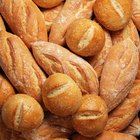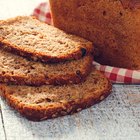Making your own bread may be a rewarding experience when you know you'll end up with a beautifully risen, airy loaf. However, this does not always happen as a novice baker, which is why you might find yourself with a dense mass of bread dough that won't seem to rise. Whether you're making a classic baguette or crusty country bread, bread dough may not rise for several reasons.
Old or Expired Yeast
The role of yeast is to metabolize the simple sugars from the flour. It does this by releasing a liquid containing carbon dioxide and ethyl alcohol into the existing air bubbles of the dough. If the yeast is old or expired, this means the organisms in the yeast that metabolize the sugars are dying or have already died. This results in a bread dough either slow to rise or that does not rise at all.
There are two ways to check if your yeast is old or expired:
- Check the expiration date on the packet or jar of yeast. Yeast is best used by 2 years from the date it was manufactured, which often is stamped on the container in the form of a month and year.
- Perform a yeast freshness test. This is the best way to determine whether yeast is alive or not. Measure out 1/2 cup of warm water in a large measuring cup. The water should be lukewarm -- not hot -- and should read approximately 110 Fahrenheit with a thermometer. Add 1 teaspoon of granulated sugar. Stir in 2 1/4 teaspoons of room-temperature yeast to this mixture and let the mixture rest for 10 minutes. If the mixture rises to the 1-cup mark after 10 minutes, then the yeast is alive. If not, toss it out and try the test again with a new packet of yeast.
Too Much Humidity
While it is preferable to bake bread in a humid oven, the same cannot be said for the environment in which the bread dough is created. When the humidity in the air is high, the extra moisture can contribute to forming a dough that is too wet or unbalanced in its ratio of liquid to flour, affecting the delicate gluten structure and rise of the dough.
Counteract the humidity by adjusting some of the ingredients in your recipe, the easiest being the amount and type of flour:
- If the dough looks too wet, add 2 tablespoons of flour at a time to the dough, stirring after each addition.
- If your recipe calls for all-purpose flour, replace the flour with bread flour, which has more gluten, which absorbs more water.
Too Much Salt or Sugar
While salt and sugar can help control and activate yeast in bread dough, too much of either can hinder the fermentation process, resulting in a dough that won't rise. Salt and sugar naturally attract moisture.
- When there's too much salt in the bread dough, excess salt absorbs some of the yeast's metabolizing liquid.
- When there's too much sugar in the bread dough, the sugar competes with the yeast for the added water in the dough.
Both scenarios decrease the strength and potency of the yeast, slowing down or hindering the fermentation process of the yeast. The only way to counteract this is to double the rest of the recipe ingredients in your dough without doubling the sugar or salt (whichever one of which you've added too much). Otherwise, you'll have to start the recipe over.
Incorrect Use of Bread Machine
While using a bread machine can result in a perfectly fine bread, there are times when using one can leave you with a bread that is dense and too stiff. The reason this often happens with a bread machine versus traditional bread-making is because once the bread ingredients have been added to the machine, the bread dough usually is left unattended for the entirety of its formation. A few tips to help you obtain a nice rise if you use a bread machine:
- Use high-gluten flours. This does not mean it has to be bread flour, but if you do use all-purpose flour, make sure it is one with a higher gluten content. Avoid whole-grain flours such as wheat and rye.
- Open the bread machine lid and check on the dough. While it is best not to open the bread machine when the dough is in its rising stage, it is fine to poke around prior to that and make sure the ratio of ingredients looks correct.
- After the dough has risen the first time around and you've reached the stage known as "giving your dough a punch," remove the bread dough from the machine and let it rise the traditional way the second time around. Do not put it back in the bread machine.
Related Articles

How to Make Breadmaker Bread Less Dense
How to Make Bread That Does Not Crumble ...

When Does Dry Yeast Expire?

How to Make Bread Chewy

Can Fast Acting Yeast Be Used in Place ...

What Happens if You Leave Bread Dough ...

How to Use a Bread Machine to Make Dough

How to Keep Homemade Bread from ...

How Does a Bread Maker Work?

What if You Forget & Let Bread Dough ...

How to Freeze Brioche

Why Does Bread Drop in the Middle When ...

Can You Substitute Yogurt for Milk in ...
How to Make Homemade Bread

How to Bake Bread in a Dutch Oven

What Happens if the Yeast Dies Before ...

How to Make Bread From Colonial Times

Does It Matter if I Substitute Baking ...
What Is the Difference Between Cake ...

How to Make Bread With Ancient Grains
References
Writer Bio
Since graduating from UCLA, self-proclaimed francophile Beeta Hashempour has worked as a baker and culinary instructor, sharing her love of French gastronomy with others. When she's not elbow-deep in flour and butter, Hashempour whips up recipes for the perfect cream puff or Paris-worthy croissants on her blog, MonPetitFour.com.